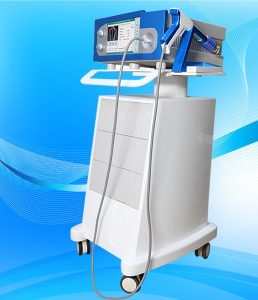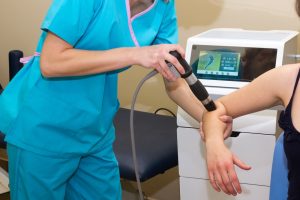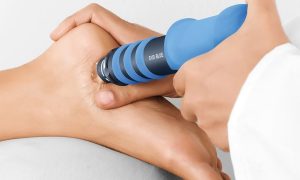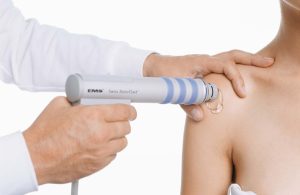ESWT (Extracorporeal Shock Wave Therapy) is a relatively new treatment method aiming to accelerate recovery and minimize pain by submitting shock waves to damaged tissues for painful musculoskeletal conditions.
Shock waves are submitted via a metal applicator with pressurized air. A special attachment that moves fast within the metal head produces shock wave at the end of the probe. The size and shape of the end of the probe vary on the application site. The energy level and frequency can be adjusted. Extracorporeal Shock Wave Therapy used in the musculoskeletal conditions utilizes the same mechanism with 10-fold lower energy.


The effect of ESWT on the tissues
The mechanism action of ESWT that reduces pain is not known. Theoretically, it is assumed that ESWT disrupts fibrous tissue generation on the relevant site and improves blood circulation, promoting recovery. It is also another theory that shock waves block neural transmission of pain to the brain.
The disorders treated with ESWT
Achilles tendinitis, enthesitis
Plantar fasciitis (calcaneal spur)
Calcific tendinitis of the shoulder
Lateral epicondylitis (tennis elbow)
Medial epicondylitis (golfer’s elbow)
Tendonitis of the foot Chronic plantar fasciitis (plantar fibromatosis)Nonunion of fracture Myofascial muscle pain Unhealed ulcerous skin scars


How Administered
ESWT is usually administered for 3-5 times at intervals of 5-7 days. The physician determines the duration and parameters (duration, frequency and pressure) of the therapy based on the patient’s condition. Some patients may benefit from the treatment at the first session while chronic patients benefit after a couple of sessions. It is possible to achieve a higher level of success when combined with other physical therapy methods and exercise.
Are there any side effects of ESWT?
ESWT does not cause any harm to the body. It does not require application of anesthesia for the treatment site. In some cases, the patient may feel some pain but this will go away after a couple of sessions. There may be mild rash and swelling at the treatment site. Except for the limited daily activities, the patient does not need to enter a special recreation period.

